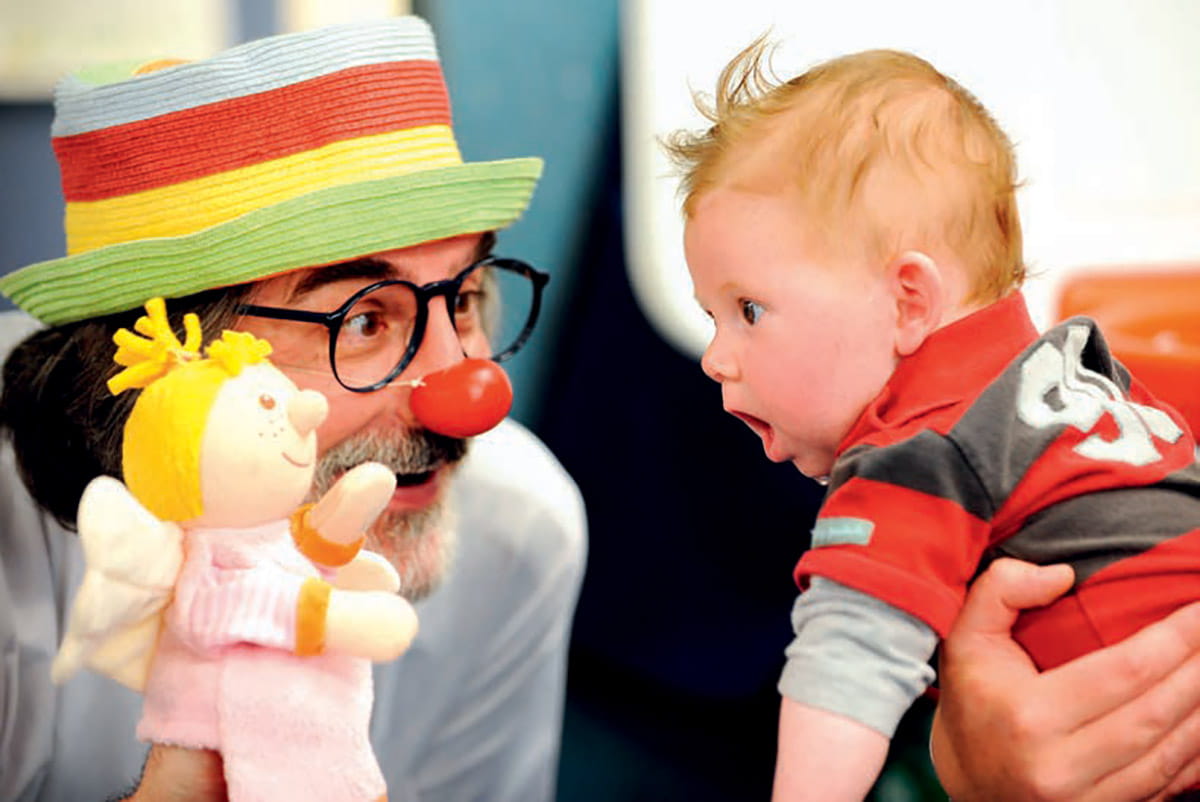Stories > A Dose of Laughter
A Dose of Laughter

Professor Thomas Petschner interacting with a child.
Medical clowns from non-profit organisation Clown Doctors Singapore help patients tide through tough times by combining humour with a touch of compassion.
BY AUDRINA GAN
PHOTOS CLOWN DOCTORS SINGAPORE
aughter, they say, is the best medicine. And Professor Thomas Petschner, a medical doctor from New Zealand, believes that so much, he founded Clown Doctors New Zealand to use humour to relieve pain and sadness among children and seniors in healthcare institutions. That was in 2009.
Then, in 2014, he met Singaporean entrepreneur CY Cheong at a charity golf tournament in New Zealand. Cheong, impressed by the cause, pledged a donation to get Clown Doctors Singapore started.
Prof Petschner also roped in Eliane Stadelmann- Boving, a former registered nurse from Switzerland, who had expressed interest in getting Clown Doctors Singapore off the ground, to serve as programme director. Although Cheong and Stadelmann-Boving left the organisation in 2015, Prof Petschner, who is chief executive officer and artistic director of Clown Doctors Singapore, continues to work with Singaporean medical clowns to put smiles on patients’ faces.
“Singapore is the ideal place to establish a main hub for the education, training and development of Clown Doctors Asia-Pacific, which is an umbrella organisation for medical clowning programmes in the region. But Singapore offers much more than the perfect geographical location – it’s a unique melting pot of cultures, religions, languages and histories,” says Prof Petschner. He adds that the country’s diversity has allowed the Clown Doctors Singapore team to create a programme that can be adapted to other countries across Asia.
To recruit medical clowns, it reaches out to interested individuals via online and television channels, and through word of mouth, to attend its auditions. Those who pass then have to enrol in an 800-hour training programme conducted by trainers from the International Institute for Medical Clowning (IIMC) at Steinbeis University Berlin.
The IIMC, founded by Prof Petschner in 2010, provides the world’s first specialised academic programme for clown doctors. Trainers from the IIMC travel to Singapore for the training. The IIMC provides the training, which typically costs S$15,000 per student, at a discounted rate for participants from Clown Doctors Singapore.
After completing their training, the certified medical clowns don lab coats and put on red noses to visit paediatric, geriatric and palliative care patients in healthcare institutions. Working in pairs, the medical clowns parody real doctors and their medical routine while interacting with patients using a variety of mediums such as singing, playing music and performing magic tricks.
HUMOUR AS THERAPY
To date, Clown Doctors Singapore has brought smiles to more than 15,000 patients, family members and hospital staff in five local institutions, such as the National University Hospital and St Luke’s Hospital. Their work was highlighted in a video on Our Better World, the Singapore International Foundation’s digital storytelling platform. This has helped to create better awareness of medical clowning as a profession and the work done by Clown Doctors Singapore.
Prof Petschner says: “Using the clown persona, we are able to lighten the mood of an environment that many associate with pain and stress. Our medical clowns are not birthday clowns or circus clowns. We do not perform or entertain. We provide therapy using humour in one-on-one interactions. We bring an extremely high level of compassion and care in addition to our artistic skills. Our work is actually more psychological and mental support than artistic performance.”
“ We provide therapy using humour in one-on-one interactions. We bring an extremely high level of compassion and care in addition to our artistic skills. Our work is actually more psychological and mental support than artistic performance. ”
Professor Thomas Petschner, co-founder, chief executive offi cer and artistic director of Clown Doctors Singapore
For instance, when the medical clowns visit the elderly, they dress in styles that were popular in the 1940s and 1950s, and play music from that period, as that was when most of the elderly patients were in their youth. These help to trigger positive memories and bring them back to a time when they were physically stronger and healthier.
There are currently six Singaporeans working as medical clowns with Clown Doctors Singapore. Aged 26 to 54, they come from diverse cultural backgrounds and professions, including actors and a community worker.
Izzaty Ishak, 26, decided to become a medical clown as she was intrigued by the idea of using the arts as a healing tool. She had taken a module in university, which explored the links between the arts and health, and that piqued her interest.
“I feel that a person’s health is based on both his or her physical and mental well-being. Medical clowning recognises that physical disease can also impact one’s mental health,” says Izzaty, a full-time community worker at charity organisation Beyond Social Services, which works with children and youth from less privileged backgrounds.
In future, Prof Petschner hopes that medical clowns become part of the allied health profession in Singapore.
